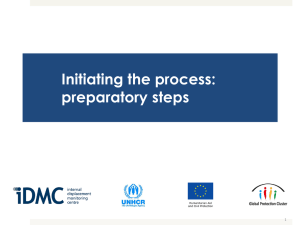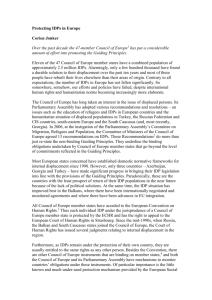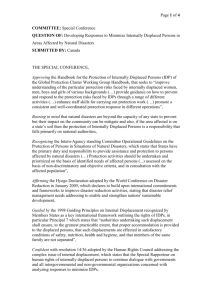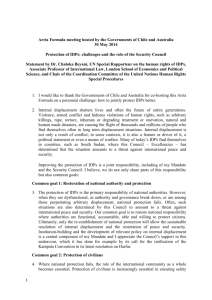At a glance Global Overview 2014: people internally displaced by conflict
advertisement
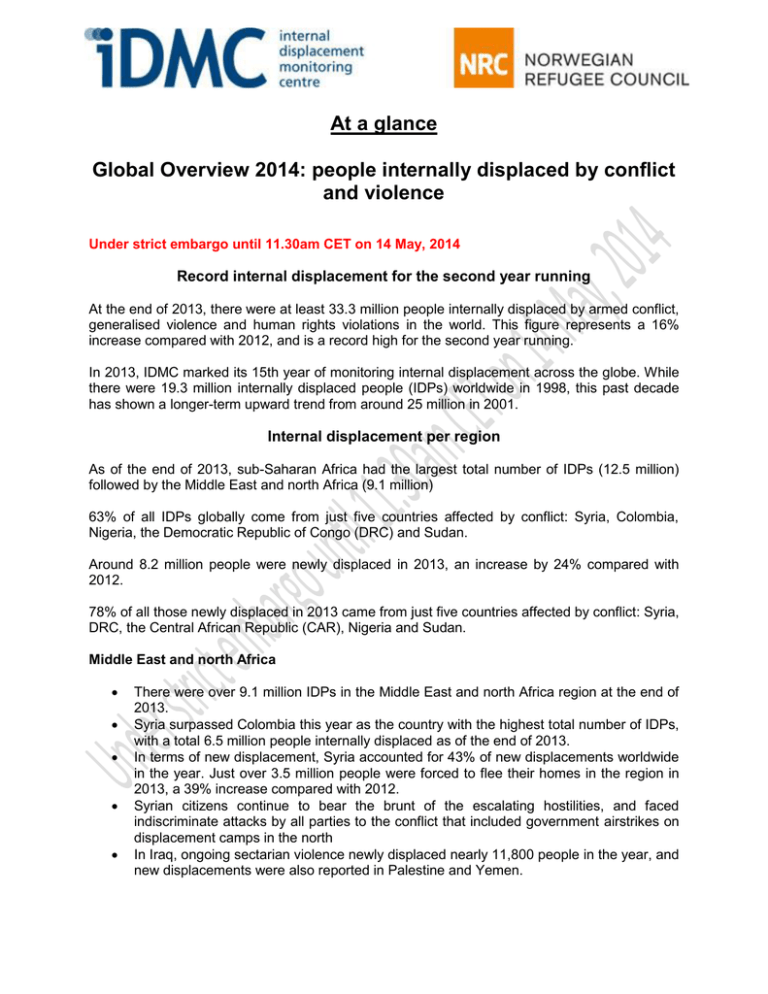
At a glance Global Overview 2014: people internally displaced by conflict and violence Under strict embargo until 11.30am CET on 14 May, 2014 Record internal displacement for the second year running At the end of 2013, there were at least 33.3 million people internally displaced by armed conflict, generalised violence and human rights violations in the world. This figure represents a 16% increase compared with 2012, and is a record high for the second year running. In 2013, IDMC marked its 15th year of monitoring internal displacement across the globe. While there were 19.3 million internally displaced people (IDPs) worldwide in 1998, this past decade has shown a longer-term upward trend from around 25 million in 2001. Internal displacement per region As of the end of 2013, sub-Saharan Africa had the largest total number of IDPs (12.5 million) followed by the Middle East and north Africa (9.1 million) 63% of all IDPs globally come from just five countries affected by conflict: Syria, Colombia, Nigeria, the Democratic Republic of Congo (DRC) and Sudan. Around 8.2 million people were newly displaced in 2013, an increase by 24% compared with 2012. 78% of all those newly displaced in 2013 came from just five countries affected by conflict: Syria, DRC, the Central African Republic (CAR), Nigeria and Sudan. Middle East and north Africa There were over 9.1 million IDPs in the Middle East and north Africa region at the end of 2013. Syria surpassed Colombia this year as the country with the highest total number of IDPs, with a total 6.5 million people internally displaced as of the end of 2013. In terms of new displacement, Syria accounted for 43% of new displacements worldwide in the year. Just over 3.5 million people were forced to flee their homes in the region in 2013, a 39% increase compared with 2012. Syrian citizens continue to bear the brunt of the escalating hostilities, and faced indiscriminate attacks by all parties to the conflict that included government airstrikes on displacement camps in the north In Iraq, ongoing sectarian violence newly displaced nearly 11,800 people in the year, and new displacements were also reported in Palestine and Yemen. Sub-Saharan Africa With more than 12.5 million IDPs in 21 countries at the end of 2013, sub-Saharan Africa remained the region with the largest number of IDPs. As in previous years, DRC’s total displaced population remained at nearly 3 million. Nigerian authorities published official figures for the first time this year, and put the number of IDPs in the country at 3.3 million. Just over 3.7 million people were newly displaced in sub-Saharan Africa in 2013, which represents a 55 % increase from 2012. As many as 1 million people fled inter-communal violence, land disputes and violence by state and non-state armed groups in DRC. The crisis in CAR escalated from March to December following a coup by the predominantly Muslim armed coalition Séléka, displacing around 935,000 people during the year. An increase in attacks by the Islamist armed group Boko Haram, heavy handed counter insurgency operations and ongoing inter-communal violence triggered the displacement of at least 470,500 people in Nigeria in 2013, while in Sudan 470,000 were newly displaced. South and south-east Asia The number of IDPs in south and south-east Asia fell for the third year running, leaving at least 3.2 million people displaced as of the end of 2013. The region’s IDPs were concentrated in seven countries – Pakistan, Myanmar, Afghanistan, India, the Philippines, Indonesia and Sri Lanka. The number of new displacements in south and south-east Asia fell by almost half, from 1.4 million in 2012 to 712,000 in 2013. Fewer people fled their homes in India and large-scale returns took place in north-west Pakistan, where the number of newly registered IDPs fell by two-thirds. Armed conflict and generalised violence displaced people in the Philippines, Pakistan and Afghanistan, which together accounted for more than 80% of new displacement in the region. The Americas By the end of 2013, at least 6.3 million people were internally displaced in the Americas. The vast majority were in Colombia, where the figure has increased consistently over a ten-year period and now stands at 5.7 million. The country’s protracted conflict is the main cause of displacement, but spreading criminal violence has also forced tens of thousands of people to flee their homes across the region including in Mexico and Honduras. The number of people newly displaced fell by around 23% in the region, from 230,000 in 2012 to 176,900 in 2013. Most new displacement took place in Colombia. The government has been in peace talks with the FARC since 2012, but in the absence of a ceasefire civilians in rural areas continue to suffer the ravages of the conflict. In Mexico, the activities of criminal groups, and large-scale military operations against them, also forced people from their homes. Europe, the Caucasus and central Asia There were still at least 2.2 million IDPs in Europe, the Caucasus and central Asia. The figure is the lowest of the five regions IDMC covers for the seventh consecutive year, but with many people having fled their homes more than 20 years ago, the protracted nature of displacement there remains a major challenge. No new displacement was reported in Europe, the Caucasus or central Asia in 2013. Key concerns Challenges of collecting data on IDPs Challenges to data collection on IDPs remain, as access to displaced people in remote areas is difficult and information is lacking on unregistered IDPs or on those who have returned, integrated locally or settled elsewhere. Also, the definition of an IDP varies from country to country. For example, in Azerbaijan, Cyprus, Georgia and Palestine, children born in displacement are counted as IDPs. As this is not the case in other countries, such differences can paint an unbalanced picture. The best available data often comes from outdated sources, with little or no reliable information to indicate the number of people who may have achieved long-term solutions. This was the case in many countries monitored by IDMC, including: Bangladesh, Burundi, India, Indonesia, Guatemala, Senegal and Thailand. The combined impact of conflict and natural hazards A natural hazard often forces IDPs to flee again, either from places where they had taken refuge from conflict, or from places to which they had returned or relocated. In the Philippines for example, those living in poorly equipped camps and makeshift shelters in central Mindanao were more exposed to flooding than their counterparts in the general population. Natural hazards and environmental degradation can also create tensions over scarce resources. In Nigeria, for example, deforestation, desertification and recurrent floods reduced sustainable access to land and other natural resources and forced many to head south in search of pastures and arable land. This put them in direct competition with local communities, leading to increased insecurity and violence. IDPs outside camps In a large proportion of countries monitored by IDMC, IDPs were living outside camps, mostly in towns and cities. This reality complicates protection and assistance due to significant information gaps concerning the number of IDPs, their specific vulnerabilities, needs, and living conditions. Key challenges for IDPs outside of camps include security of tenure, substandard housing and living conditions, and the risk of increased vulnerability and marginalisation, especially in towns and cities where they can be exposed to forced evictions. For example, Iraqi IDPs living in and around informal settlements in Baghdad are under constant threat of eviction, and similar concerns are faced by urban IDPs in countries such as Afghanistan, Somalia and Colombia. Protracted displacement After an initial crisis passes, less visible challenges remain for displaced populations that are often harder to overcome. Without sustained leadership and commitment from a broad range of organisations and institutions, IDPs are often unable to resolve their displacement and have no prospect of rebuilding their lives or achieving a durable solution. In Bangladesh and Cyprus, for example, IDPs have been living in protracted displacement since the 1970s, and IDPs in Myanmar, Palestine and Colombia for even longer, with displacement dating back to the 1960s. The assessment of IDPs’ progress towards achieving a durable solution requires gauging whether they have become more or less vulnerable over time, which in turn requires a significant long-term investment in data gathering. Response to displacement 15 years on Calls for a more nuanced understanding of the causes and effects of displacement, alongside the year-on-year increases in the numbers of IDPs around the world, re-emphasise the need for fundamental changes in efforts to prevent and respond to internal displacement. Despite a strong consensus at the global level on the need to develop coordinated and longterm strategies to respond to displacement, the challenge ahead lies in overcoming the perception of internal displacement as a solely humanitarian issue and positioning it as a matter for development agencies, private companies and others to address in order to move towards long-term solutions to displacement. 2013 served as a stark reminder that emergency response systems still need a lot of improvement. With 8.2 million people forced to flee their homes, the concurrent crises in 2013 went beyond what anyone could have prepared for. They put enormous strain on the humanitarian system and tested its ability to respond to unparalleled needs. *Percentages based on calculations from actual (not rounded) figures
